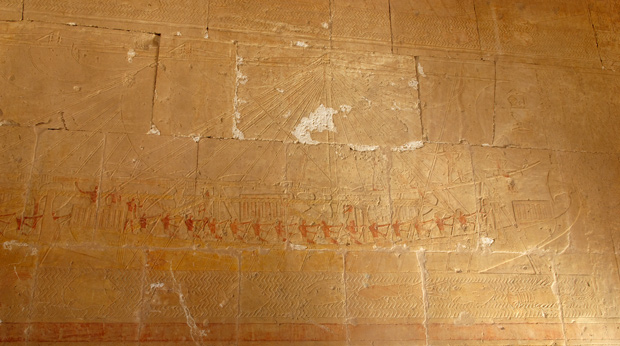It looks like you're using an Ad Blocker.
Please white-list or disable AboveTopSecret.com in your ad-blocking tool.
Thank you.
Some features of ATS will be disabled while you continue to use an ad-blocker.
share:
reply to post by punkinworks10
these guys can be very unpleasant if you snorkel around and they are breeding at the moment.
these guys can be very unpleasant if you snorkel around and they are breeding at the moment.
reply to post by SLAYER69
Great post. S&F
Some readings suggest that indeed the Egyptians made it to the Americas.
LINK
And another one wondering about the presence of egyptians in America back in time.
LINK2
Great post. S&F
Some readings suggest that indeed the Egyptians made it to the Americas.
With the passage of time, persistent researchers normally manage to unearth new information to enrich previous works. This is the case with Paul Gallez on the subject of ancient Egyptians in America, published in Predescubrimientos de América (Instituto Patagónico, Bahía Blanca 2001, p 52 onwards). Gallez says: ‘In 1976, Barry Fell (América A.C. Los primeros colonizadores del Nuevo Mundo. México, Diana 1983) gave his translation of a tri-lingual inscription found on a funeral mound in Davenport, Iowa, that describes the Egyptian new year celebration held on the March equinox. The three languages are Egyptian, Iberian Punic and Libyan. This stone has been dated at 800 BC, during the twenty-first Egyptian dynasty (Libyan). The phrases referring to astronomy and religion in traditional ancient Egyptian characters only vary in passages copied by different hands'. According to French television, he adds, an Egyptian mummy dating from the same twenty-first dynasty was perfumed with tobacco and coc aine, two typically American products.
LINK
And another one wondering about the presence of egyptians in America back in time.
LINK2
Originally posted by SLAYER69
A relief at the temple of the female pharaoh Hatshepsut in Luxor, Egypt, carved ca. 1480 B.C., shows a merchant ship on a trading expedition. Vessel artifacts match this depiction
Egypt's Ancient Fleet: Lost for Thousands of Years, Discovered in a Desolate Cave
An ancient harbor on the Red Sea proves ancient Egyptians mastered oceangoing technology and launched a series of ambitious expeditions to far-off lands.
The scenes carved into a wall of the ancient Egyptian temple at Deir el-Bahri tell of a remarkable sea voyage. A fleet of cargo ships bearing exotic plants, animals, and precious incense navigates through high-crested waves on a journey from a mysterious land known as Punt or “the Land of God.” The carvings were commissioned by Hatshepsut, ancient Egypt’s greatest female pharaoh, who controlled Egypt for more than two decades in the 15th century B.C. She ruled some 2 million people and oversaw one of most powerful empires of the ancient world.
The exact meaning of the detailed carvings has divided Egyptologists ever since they were discovered in the mid-19th century. “Some people have argued that Punt was inland and not on the sea, or a fictitious place altogether,” Oxford Egyptologist John Baines says. Recently, however, a series of remarkable discoveries on a desolate stretch of the Red Sea coast has settled the debate, proving once and for all that the masterful building skills of the ancient Egyptians applied to oceangoing ships as well as to pyramids.
This is a fascinating but short read. Many have speculated and debated for years about just how much were the Ancient Egyptians seafarers. It seemed reasonable to me that if they were capable of building some of the greatest monuments known to man that they surely could have built a sea worthy craft not to mention a trading fleet and set sail off over the horizon. I mean they knew the stars and that's exactly what early seafarers relied on to navigate.
The question then becomes just how early did they first set out and how far did they travel?
Thought?edit on 25-8-2012 by SLAYER69 because: (no reason given)
I guess it is true about egyptian artifacts in the new world. Remember there have been reports over the decades of caves, old mounds and things from south and north america being found here and over in egypt. As I said before I think that before the cataclysm, we had a world civilization that was maritime and it was traveling back and forth between the continents (the issue with antartica being mapped before satellite).
The only thing I can add is Deir el-Bahri Temple is not the true name of the temple. I have always been curious to what it means. In Tigrinya
(Eritrea's National Language) Dirhi Bahri means "Behind the River". This temple is located behind a river from the vantage point of Luxom when
asking for directions. ( Kind of like Canada misunderstood naming which really means "The Village" lol)
Source: I am Eritrean. and fluent in my language
Source: I am Eritrean. and fluent in my language
new topics
-
Trump-appointed judge blocks Biden administration overtime rule
Social Issues and Civil Unrest: 16 minutes ago -
Don't cry do Cryo instead
General Chit Chat: 5 hours ago -
Tariffs all around, Except for ...
Dreams & Predictions: 7 hours ago
top topics
-
Bucks County commissioners vote to count illegal ballots in Pennsylvania recount
2024 Elections: 17 hours ago, 23 flags -
Gen Flynn's Sister and her cohort blow the whistle on DHS/CBP involvement in child trafficking.
Whistle Blowers and Leaked Documents: 12 hours ago, 8 flags -
Don't cry do Cryo instead
General Chit Chat: 5 hours ago, 5 flags -
Anybody else using Pomodoro time management technique?
General Chit Chat: 14 hours ago, 3 flags -
Tariffs all around, Except for ...
Dreams & Predictions: 7 hours ago, 3 flags -
Trump-appointed judge blocks Biden administration overtime rule
Social Issues and Civil Unrest: 16 minutes ago, 0 flags

